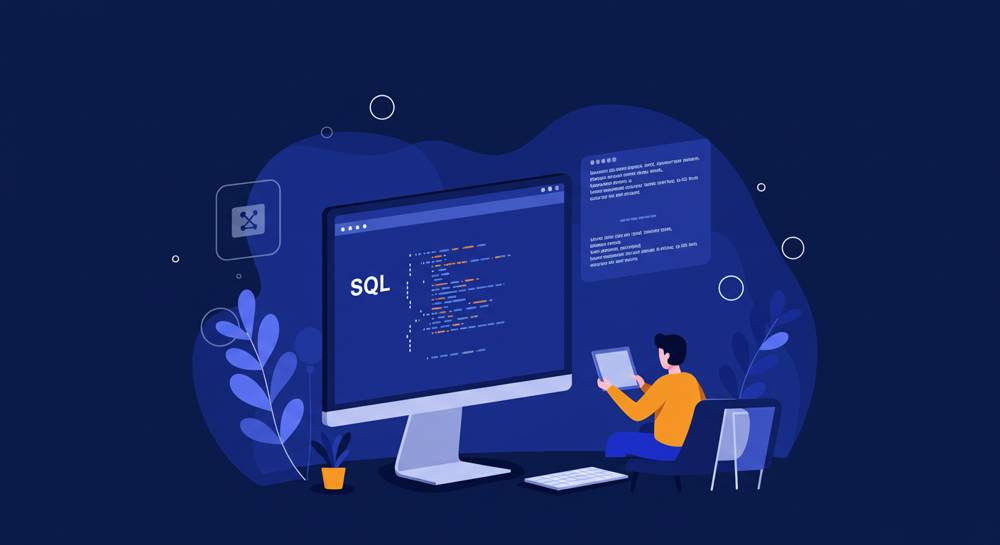- Start Learning SQL
- Core SQL Concepts
- SQL Data Types
- Data Definition Language (DDL) Commands
- Data Query Language (DQL) Commands
- Data Manipulation Language (DML) Commands
- Data Control Language (DCL) Commands
- Transaction Control Commands
- Joining Tables
- Aggregate Functions
- Subqueries in SQL
- Advanced SQL Concepts
- Performance Tuning SQL Queries
- Security and Permissions
In this article, you can gain valuable training on SQL, a fundamental skill for any developer dealing with databases. Whether you are looking to refine your existing skills or dive deeper into SQL programming, this tutorial provides a comprehensive guide tailored for intermediate and professional developers.
Introduction to SQL Programming
Structured Query Language (SQL) is the standard language for managing and manipulating relational databases. It enables developers to perform tasks such as querying data, updating records, and managing database structures. Understanding SQL is essential for anyone involved in data analysis, backend development, or database administration.
What is SQL?
SQL was developed in the early 1970s at IBM and has since become the dominant language for database interaction. The core strength of SQL lies in its declarative nature, allowing developers to specify what data they want rather than how to retrieve it. This abstraction simplifies complex database interactions, making it easier to focus on the data itself.
SQL can be categorized into several sublanguages:
- Data Query Language (DQL): Used for querying data (e.g.,
SELECTstatements). - Data Manipulation Language (DML): Used for modifying data (e.g.,
INSERT,UPDATE,DELETE). - Data Definition Language (DDL): Used for defining and modifying database structures (e.g.,
CREATE,ALTER,DROP). - Data Control Language (DCL): Used for controlling access to data (e.g.,
GRANT,REVOKE).
Key Features of SQL
SQL has several key features that make it a powerful tool for developers:
- Portability: SQL is standardized, so basic SQL commands can often be used across different database systems (e.g., MySQL, PostgreSQL, SQL Server).
- Flexibility: SQL can handle a wide variety of data types, making it suitable for various applications.
- Powerful Querying Capabilities: With SQL, you can perform complex queries, aggregations, and data manipulations with relative ease.
- Transaction Management: SQL supports transactions, enabling developers to execute a series of operations as a single unit of work, ensuring data integrity.
Understanding these features will help you leverage SQL more effectively in your projects.
Writing Your First SQL Query
Now that you have a foundational understanding of SQL, it’s time to write your first query. For this tutorial, let’s assume you have a database for a bookstore, and you want to retrieve information about the books available.
Setting Up Your Environment
Before we dive into writing SQL queries, ensure you have access to a SQL database. You can use platforms like:
- MySQL: An open-source relational database management system.
- PostgreSQL: A powerful, open-source object-relational database system.
- SQLite: A lightweight database that's great for small projects.
Writing the Query
Let’s start with a simple SELECT statement to retrieve book titles from a table named books. The SQL syntax for this would be:
SELECT title FROM books;This query retrieves all titles from the books table. Remember that SQL statements are case-insensitive, but it is a common practice to write keywords in uppercase for readability.
Adding Conditions
To make your query more specific, you can add a WHERE clause. For instance, if you want to find all books authored by "Jane Austen", you would write:
SELECT title FROM books WHERE author = 'Jane Austen';This query filters the results, returning only the titles of books where the author is Jane Austen.
Using Functions and Aggregations
SQL is not just about retrieving data; it also allows for data manipulation through functions. For example, if you want to count how many books are written by each author, you can use the COUNT() function along with GROUP BY:
SELECT author, COUNT(*) as book_count
FROM books
GROUP BY author;This query groups the results by author and counts the number of books for each author, providing insights into your data.
Joining Tables
In real-world scenarios, data is often spread across multiple tables. SQL allows you to join these tables to retrieve comprehensive datasets. For example, if you have a sales table that records each book sale, you could join it with the books table to find out how many copies of each book were sold. The query might look like this:
SELECT b.title, COUNT(s.id) as sales_count
FROM books b
LEFT JOIN sales s ON b.id = s.book_id
GROUP BY b.title;This query uses a LEFT JOIN to include all books even if they have not been sold, counting the number of sales associated with each book title.
Best Practices
When writing SQL queries, consider these best practices:
- Use meaningful names: Use clear and descriptive names for tables and columns to make your queries self-documenting.
- Comment your code: Use comments to explain complex queries or provide context.
- Optimize for performance: Be mindful of how your queries might affect performance, especially with large datasets. Use indexing wisely to speed up query execution.
Summary
SQL is an essential tool for developers, providing powerful capabilities for managing and manipulating data within relational databases. In this article, we explored the basics of SQL programming, from understanding its core concepts to writing your first query. You learned how to retrieve data, filter results, and utilize functions and joins to enhance your queries.
As you continue your journey in SQL, remember to practice regularly and explore more advanced topics such as stored procedures, triggers, and database optimization. Resources like the official SQL documentation can also provide deeper insights and guidance.
By mastering SQL, you gain the ability to harness the full potential of your data, paving the way for more informed decision-making and robust application development.
Last Update: 19 Jan, 2025

